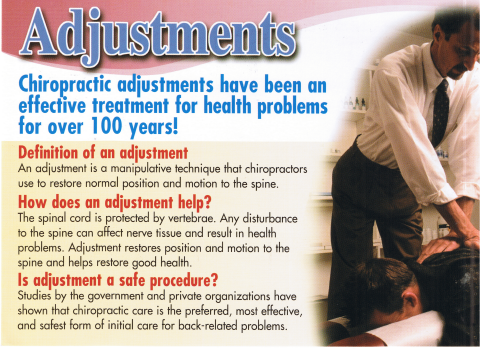Patient Outcomes Proves More Effective with Chiropractic Combined with Standard Medical Care Than Standard Medical Care Alone in the Military
Patient Outcomes Proves More Effective with Chiropractic Combined with Standard Medical Care Than Standard Medical Care Alone in the Military
BY: D. Scott Ferguson
DC, William J. Owens DC, DAAMLP
Mark Studin DC, FASBE(c), DAAMLP, DAAPM
Many people suffer from lower back pain at some point in their lives. Most will seek the advice of a healthcare professional. However, many times this care is fragmented and not based on current evidence and can result in poorer outcomes. When considering outcomes, all doctors must consider creating a diagnosis, prognosis and then conclude a treatment plan. It is that treatment plan, which then determines the outcome after an accurate diagnosis. Many times, low back pain patients seek solely standard medical care and bypass a more effective chiropractic solution. This type of self-referral and physician triage has also been prevalent in the military and asks the question based upon outcome studies, is that in the best interest of both the military and the general public?
In a recent paper by Goertz et al. (2013), the objective was, “To assess changes in pain levels and physical functioning in response to standard medical care (SMC) versus SMC plus chiropractic manipulative therapy (chiropractic adjustments) for the treatment of low back pain among 18 to 35-year-old active-duty military personnel” (p. 627). The authors stated, “Lifetime prevalence of low back pain has been estimated to be as high as 84%, with a median cost per quality-adjusted life year of $13,015” (p. 627). The fact that lower back pain is a major source of disability and abuse of pain medication makes providing the best care possible a priority based upon outcome studies. In this paper, it was reported that, “The majority of systematic reviews find that chiropractic manipulative therapy (adjustments) seems to reduce pain and disability at least moderately for many patients with low back pain” (p. 627). Therefore, the questions are, “Should chiropractic care be part of your treatment plan and should it be included with standard medical treatment for lower back pain?”
In the Goertz et al. (2013) study, the patients were allowed to seek standard medical care in an unrestricted fashion which meant they could go to their medical doctors as they normally would for lower back pain. “Standard care included any or all of the following: a focused history and physical examination, diagnostic imaging as indicated, education about self-management including maintaining activity levels as tolerated, pharmacological (drug) management with the use of analgesics and anti-inflammatory agents, and physical therapy and modalities such as heat/ice and referral to a pain clinic” (p. 628). On the chiropractic side, the authors stated “Treatments consisted of HVLA [high velocity low amplitude a.k.a. chiropractic adjustment] manipulation as the primary approach in all cases, with ancillary treatments at the doctor’s discretion, including brief massage, the use of ice or heat in the lumbar area, stretching exercises, McKenzie exercises, advice on activities of daily living, postural/ergonomic advice; and mobilization” (p. 628). This is important since chiropractors view the spine as an entire system and the approach to patients is different as well as the therapeutic intervention.
In conclusion, the authors reported, “The results of our pragmatic pilot study indicate a statistically and clinically significant benefit to those receiving chiropractic manipulative therapy (adjustments) in addition to standard medical care” (p. 631). Finally, they report, “The results of this trial suggest that chiropractic, in conjunction with standard medical care, offers a significant advantage for decreasing pain and improving physical functioning compared with only standard medical care, for active-duty men and women between 18 and 35 years of age with acute low back pain when delivered in a pragmatic treatment setting” (p. 633).
This study concurs with a previous study by Liliedahl et al. (2010) who studied 85,402 patients and adds to the growing body of evidence in diverse forums that chiropractic for mechanical back pain is more effective and cost-effective than standard medical care. Evidence such as this helps to dispel the partial truths and overcome the prejudices to help the public make informed choices.
References:
1. Goertz, C. M., Long, C. R., Hondras, M. A., Petri, R., Delgado, R., Lawrence, D. J.,…Meeker, W. C. (2013). Adding chiropractic manipulative therapy to standard medical care for patients with acute low back pain: Results of a pragmatic randomized comparative effectiveness study. Spine, 38(8), 627-634.
2. Liliedahl, R. L., Finch, M. D., Axene, D. V., & Goertz C. M. (2010). Cost of care for common back pain conditions initiated with chiropractic doctor vs. medical doctor/doctor of osteopathy as first physician: Experience of one Tennessee-based general health insurer. Journal of Manipulative and Physiological Therapeutics, 33(9), 640-643.


Hi there, I check your blogs daily. Your story-telling style is awesome, keep it up!|
Hi there, just became aware of your blog through Google, and found that it is truly informative. I am gonna watch out for brussels. I will appreciate if you continue this in future. Numerous people will be benefited from your writing. Cheers!|
I do fine with wordpress just read the comments one at a time before I approve or delete them.
obviously like your website however you need to test the spelling on quite a few of your posts.
Many of them are rife with spelling problems and I find it
very troublesome to inform the reality on the other
hand I will definitely come back again.
I’ll work on it. Thanks
Simply wish to say your article is as amazing. The clarity on your publish is simply cool and that
i can suppose you’re an expert on this subject. Well with your permission let
me to grab your RSS feed to stay updated with approaching post.
Thank you 1,000,000 and please carry on the gratifying work.